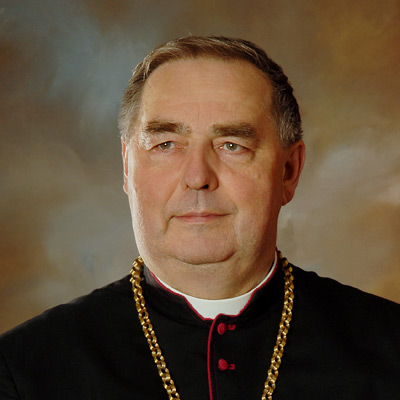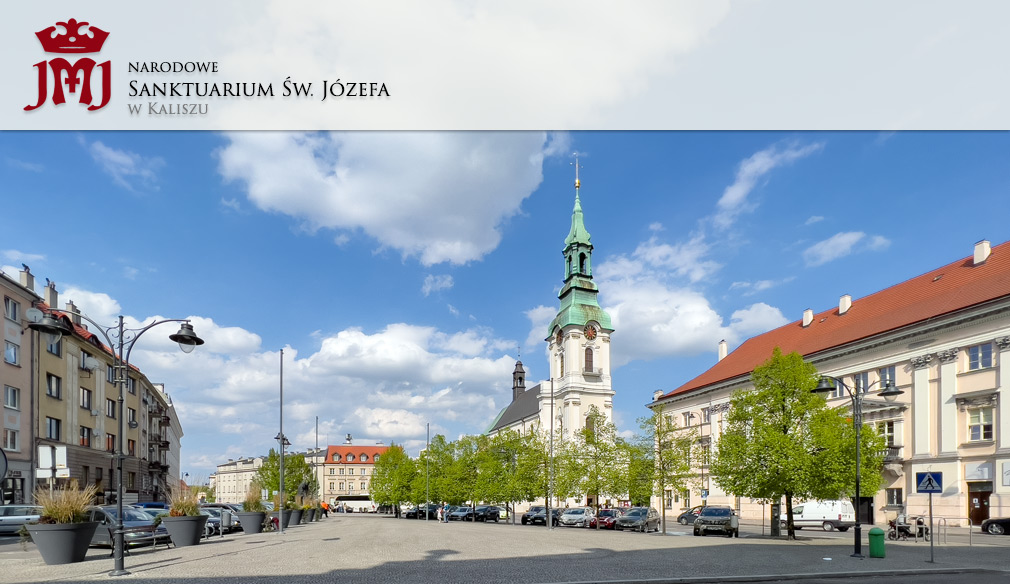The cult of St. Joseph

Since the beginning of the 17th century, Kalisz has been one of the main places of worship of St. Joseph in Poland. This was closely tied to a picture of the Holy Family.
According to tradition, St. Joseph’s Shrine in Kalisz can be traced back to the year 1670, when an inhabitant of Szulec village was healed through St. Joseph’s intercession. He later founded a picture of the Holy Family as a votive offering, and placed it in the Kalisz Collegiate Church in the altar that he had also founded.
The late 17th and the entire 18th century marked an intensive flourishing of the cult of St. Joseph. Polish theologians referred to this period as “the golden age” of Josephology.
A slight decline in the cult can be observed between the late 18th and early 20th century, however even then two solemn festivities enlivened it, namely the centenary of the coronation of the picture of the Holy Family in 1896 and the 50th anniversary of St. Joseph’s patronage over the Włocławek diocese in 1930.
After World War II, three events in particular contributed to the significant development and meaning of the cult of St. Joseph of Kalisz. The first one was the miraculous liberation of priests, former prisoners, from the Dachau concentration camp (April 29th, 1945). The second one was the founding of the Polish College of St. Joseph in Kalisz (September 24th, 1969). And the last one, was Pope John Paul II’s visit to the Kalisz Shrine, which was the main contributor to the fame of St. Joseph of Kalisz.
In Kalisz, as the Bishop of Rome, John Paul II entrusted all the Polish families and the issue of the protection of preborn children in Poland and the rest of the world to St. Joseph.
Initially, the Holy Family was chosen as the patron saint of the diocese. A year later a papal brief arrived from the Apostolic See stating that “St. Joseph, the husband of the Virgin Mary, the Guardian of the Saviour” is to become the patron saint of the Kalisz diocese. This entitlement of the patron undoubtedly refers to the picture of St. Joseph of Kalisz depicting the Holy Family: Jesus the Saviour, Mother Mary and her husband St. Joseph.
The decision to make St. Joseph the patron saint of the Kalisz diocese is a well-founded and meaningful one. In the past, saints chosen as patrons of a given area were somehow connected to it. As mentioned earlier, the cult of St. Joseph in Kalisz had been intense since the middle of the 17th century. It was related to the so-called “St. Joseph of Kalisz” picture, which attracted people who prayed before it, and asked for St. Joseph’s intercession and were in return granted many graces and even miracles. It seems that this was a decisive factor in the choice of this patronage.
StanisławNapierała , the first bishop of the Kalisz diocese, knew how valuable this patron saint would be for the young local Church, which is why he concluded, that St. Joseph would be the one unifying and integrating the diocese. Therefore, he decided that a copy of the picture of St. Joseph of Kalisz would peregrinate to each and every parish of the diocese. Thus during the first diocesan thanksgiving pilgrimage to Rome, the delegates took two copies of the picture of St. Joseph of Kalisz with them. They asked the Holy Father John Paul II to keep one, as an expression of their gratitude and love, and to bless the other, which would commence its peregrination, with the launch of a pastoral programme focused on the family.
The Holy Father uttered these memorable words at that time: “(…) you are bringing with you a copy of the picture of St. Joseph worshiped in Kalisz, in the Shrine known all across Poland, and asking me to bless it. After returning to Poland it is to peregrinate to each parish of the diocese. St. Joseph is very dear and close to you… It is good that your diocesan pastoral programme is starting with the family. (…) The family is one of the most valuable goods of humankind. (…)”
After returning from Rome the blessed picture of St. Joseph of Kalisz was taken in by nuns, who welcomed it in their homes. They prayed for God’s blessing for the parishes which St. Joseph would visit.
The inauguration of the peregrination took place on April 17th, 1994. Archbishop JózefKowalczyk, Apostolic Nuncio in Poland, celebrated Holy Mass at St. Joseph’s Square, together with priests and representatives from all the parishes of the diocese. During the week preceding the inauguration, numerous pilgrimages visited the Shrine of St. Joseph: priests and seminarians, nuns, the sick and the elderly, couples and families, the unemployed and the youth; each group had their own day. The peregrination lasted for over two years (from April 17th, 1994 to June 3rd, 1996).
The peregrination had fulfilled the great hopes placed in it – it raised a greater awareness and strengthened the sense of diocesan community. The time of peregrination revived the cult of St. Joseph of Kalisz, who having visited each parish, remained there spiritually. St. Joseph is also present physically in many copies of the picture venerated in homes, churches and chapels.
The fact that the bishop of the Kalisz diocese himself leads the main ceremonies in the Shrine celebrating St. Joseph emphasizes the diocesan dimension of the cult of St. Joseph of Kalisz. Each year, the bishop inaugurates the Poland-wide Symposium of St. Joseph, celebrates Mass and says the homily during numerous nationwide pilgrimages to the Shrine: of priests of former prisoners from the Dachau concentration camp (annually on April 29th), the workers (from May 1st 1993), the Catholic women’s association (from April 8th 1995), the Civitas Christiana Movement (from November 30th 1996), the Home Church Circles (from March 28-29th 1998) and others.
Each year, the bishop celebrates the main Eucharist on March 19th (the Feast of St. Joseph) as well as on the Feast of the Protection of St. Joseph. It was formerly celebrated on the fourth Sunday after Easter; however the bishop moved it to the first Sunday of June in order to celebrate it together with the anniversary of the Holy Father John Paul II’s visit to Kalisz. On the eve of this day, there is a Kalisz-wide procession, during which a copy of St. Joseph’s picture is carried from St. Wojciech’s Church to the Shrine of St. Joseph.
One of the oldest walking pilgrimages in Poland – from Kalisz to JasnaGóra [the Shrine of the Holy Mary] and back – is closely related to the cult of St. Joseph. It started in 1637. The close connection with the Kalisz Shrine is expressed by the fact that it departs from the Shrine and returns to it (from Joseph to Mary and from Mary to Joseph). Moreover, the awareness of pilgrims is also apparent in their songs, prayers, reproductions of the picture of St. Joseph and others. The pilgrims departing from other cities in the Kalisz diocese are also increasingly aware of the connection with St. Joseph.
Each year, 400 priests and over 100 seminarians from the Kalisz diocese, led by the bishop, take part in a pilgrimage to St. Joseph of Kalisz. Young priests also celebrate their first Mass at St. Joseph’s Chapel. Moreover in July and August, deacons carry out their summer practicums at St. Joseph’s Shrine, during which time they serve the pilgrims.
It is also worth mentioning that as of February 8th, 1997 confessions are heard all day, every day so that the pilgrims and visitors to Joseph’s Basilica can take advantage of this opportunity.
The nationwide thanksgiving for 50 years of peace after World War II, celebrated in 1995, was another important event connected with St. Joseph. This solemn ceremony was attended by 57 bishops from Poland, all the priests from the Kalisz diocese, seminarians and priests who were former prisoners in the Dachau concentration camp.
StanisławNapierała, the Bishop of Kalisz declared a Diocesan Jubilee Year from the 15th of May 1996 to the 14th of May 1997 to celebrate the 200th anniversary of the coronation of St. Joseph’s Picture,
The Kalisz faithful have never doubted that the so-called “silent Saint” was looking after of their city. A short prayer inscribed on the votive plaque from 1756 confirms this: “Father of our Saviour and Redeemer, Patron Saint of our adventures, God has given His Son and the whole world to You to defend, the city of Kalisz is entrusting itself to Your care as well, therefore let us experience the care of your patronage”.
Seeing the extraordinary growth of the cult of St. Joseph and the Kalisz population’s awareness of the significance of this great Saint for their city, StanisławNapierała the Bishop of Kalisz, in cooperation with the City Council, wrote a letter dated May 10th, 1997 to The Holy See in order to obtain an official document confirming St. Joseph’s guardianship over Kalisz. The Bishop received the requested document from the Congregation of Divine Worship and Means of Grace on the 30th of August 1997. On June 4th, 1998, on the first anniversary of Pope John Paul II’s visit to Kalisz, St. Joseph was formally declared the Patron Saint of the city.
It is also worth mentioning, that St. Joseph is the Patron Saint of the Theological Seminary of the Kalisz diocese. A copy of St. Joseph’s Picture found in the chapel of the Theological Seminary, peregrinates throughout all parishes in the diocese.
The worship of St. Joseph is spreading across the diocese, as catechetical rooms, parish houses and other parish initiatives are being named after this great Saint. Furthermore, many of the parishes within the Kalisz Diocese have introduced various devotions, prayers and songs to our Saint. Each Wednesday our local radio station ‘Family Radio’, transmits from the Theological Seminary Chapel, where the novena prayer to St. Joseph is being prayed. Pilgrims visiting St. Joseph’s Basilica are able to choose from a wide selection of pictures, leaflets, books and other souvenirs connected with the Great Saint.
Over the past few years we have observed a greatexpansion of the cult of St. Joseph. Many pilgrimages from the entire diocese and all of Poland are coming to our Shrine. St. Joseph has many secret worshippers and many people have made him their intercessor to God.
A novelty connected to the discovery of St. Joseph by the modern world, is the fact that St. Joseph, as Mary’s husband and the father of Jesus is the patron saint of all those whom the world seems to reject; the poor, the homeless, the unemployed, and the sick. At the outset of the third millennium, Pope John Paul II pointed to St. Joseph, as an example and a helper to the world. The Polish Episcopal Conference has established the first of May 2001 (liturgical reminiscence of St. Joseph’s the worker) as the Poland-wide Day of Prayer and Solidarity with the jobless. St. Joseph aids in our temporal affairs but first and foremost he leads us to God.




